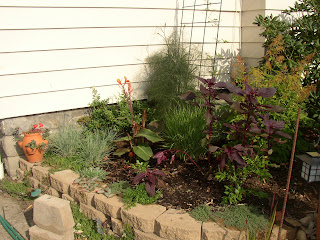Generally, when I think of "corporate" or "public" landscaping I think rows of Japanese barberry and burning bushes, with tons of daylilies--mostly Stella D'Oro--stuffed in for summer color. Recently, some places have gone a bit trendier and started to mix in ornamental grasses as well. But a few places I haunt in the Cleveland area have really put some thought and imagination into their landscaping, and I admit to being inspired.

The city of Brecksville, which is near where I work, does interesting containers like this one. Orange celosia, Non-Stop begonias, variegated geraniums, and orange-edged acalypha stuff this container full of warm color. Its two smaller companion pots feature a bronze cordyline, more of the celosia, and silver trailing lotus vine. I like how the fine textures of the lotus vine and the asparagus fern used as filler in the larger center pot echo each other nicely.
It's not just containers that the Brecksville public works department does well, either. In their town square they have annual beds featuring dark-leaf cannas paired with ornamental grasses, bronze- and purple-leaf dahlias, and even "lowly" marigolds and salvias. Similar combinations grace the ends of long berm beds that split several 4 lane roads through town. In between the annual beds these berms still show 3+ seasons of color thanks to a low-maintenance mix of euphorbias, Russian sage, spring bulbs and various grasses.
Another place that does annual color well is
Crocker Park, and upscale "shopping community" in Westlake. Some of their great containers include large bronze-glazed ceramics planted with just one type of orange- and yellow-flecked coleus, and huge pots with forest-worthy stands of dark-leaf cannas underplanted with enough cascading pineapple mint to keep me in tea for a decade.

The adjacent (and older) Promenade shopping center has long boasted wonderful landscaping in small beds that had been inset in the sidewalks, as well as a large burst of color in the fountain area that separates my favorite Borders bookstore from a large cineplex. Hardy hibiscus, various roses, and large mugo pines have formed the backbones of this area for the past few years, but the annuals really make the area special during the summer months. (You can click on any of the pictures to see details.)

In the first picture you see the hibiscus tucked in amongst a red-flowering, red-leaf celosia and a red-and-yellow flowering lantana. The silvery carpet underneath it is 'Silver Falls' dichondra. In the second picture, you see another bed with hibiscus and red celosia, but this one includes white geraniums, dark purple angelonia, and the refreshing combination of 'Cerveza 'n Lime' plectranthus and blue fescue.

A nearby bed goes more for the cool end of the color wheel with blue fescues, bronze cordyline, white petunias, Mexican heather, some kind of dark purple alternanthera, yellow-variegated grass, and 'Black Pearl' ornamental pepper. The black-eyed susan appears to be a self-seeded accident at first glance, but it adds some much-needed height there and a great leaf contrast as well so I believe that it was an intentional addition.

See the yellow coleus edging the separate bed further back in picture two? It compliments the yellows and purples in this front bed so nicely, and also leads your eye past the edge of the bed and over the sidewalk into the next area of color. That's another thing they do particularly well in this maze of beds around the fountain.
I am learning a few tricks from both of these public landscaping examples. From Brecksville, I am learning how to work with annuals that have interesting leaves and artfully combine them. From Crocker Park, I am learning to better use annuals to fill in my regular planting beds. I don't really know why, but I tend to keep my annual color in containers instead of putting them directly in the ground... now I see what I've been missing!
And from both, I'm getting ideas on how better to echo the colors and textures of key plants to make for a cohesive look in the garden. Hopefully learning these lessons will help keep my garden from being too "bitty"... but I'll have more thoughts to share on that score tomorrow.

 In the best of these insufficient pictures, you get a mere hint of the rich ruby embers provided by the 'Purple Knockout' salvia lyrata, a taste of the hearty amber glow of the carex buchanii, and a suggestion of the smooth silvery backdrop of sea kale leaves.
In the best of these insufficient pictures, you get a mere hint of the rich ruby embers provided by the 'Purple Knockout' salvia lyrata, a taste of the hearty amber glow of the carex buchanii, and a suggestion of the smooth silvery backdrop of sea kale leaves.


















